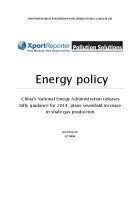Green energy
Energy Policy
Feb 07 2014
Author: Xport Reporter on behalf of XportReporter
China’s National Energy Administration (NEA) released the 2014 Guidance for Energy Administration (No.38), an annual document that sets goals across the country’s energy sector, on 20 January. This year’s guidance highlights the launch of nuclear projects examination and approvals, which will open the USD 9.92bn (CNY 60bn) equipment market. The guidance also targets 1.5bn cubic meters shale gas production in 2014, seven times more than 2013’s 200m cubic meters. The document also touches upon reforms on coal consumption, power, oil and gas, and safety supervision. Although it covered different aspects, how to enforce and cooperate with other regulatory bodies and state owned enterprises is still a hurdle to overcome.
Launch nuclear power projects approval
The guidance calls for an increase of nuclear power installed capacity of 8.64 GW in 2014. To reach the target, NEA will launch examination and approval for key nuclear power projects, promote construction along coastal region with steady progress, and strengthen inland nuclear power sites protection.
China currently has 17 nuclear power units, with a total capacity of 14.74 GW, and 29 nuclear power units under construction, which will start operation in 2015 with a capacity of 31.66 GW. However, according to the State Council’s Air Pollution Prevention and Control Action Plan released in last September, China is to have 50 GW installed nuclear power capacity by 2017.
The country needs to start building at least four nuclear units this year to deliver the target, as the construction cycle for nuclear power is around 50 months. A GW-level nuclear unit costs USD 2.48 (CNY 15bn), making the nuclear equipment market for 2014 reaching USD 9.92bn (CNY 60bn), according to Xinhua news.
This is the second time in a month that NEA has expressed willingness to launch approvals for new projects. Earlier this month, the head of NEA, Wu Xinxiong said at the National Energy Meeting that the AP1000 will be mature by June, and the initial design of C AP1400 has passed review.
Ambitious shale gas production goal
As part of the government’s effort to optimize the energy structure, NEA’s guidance says to produce 13.1bn cubic meters of natural gas in 2014, including 1.5bn cubic meters of shale gas, and 18bn cubic meters of coal bed methane. Though, the numbers of shale gas and coal bed methane production represent huge leaps from the 2013 level of 200m cubic meters and 3bn cubic meters, respectively, according to the Ministry of Land Resources.
In order to break through shale gas production, NEA plans to promote Sinopec’s successful experience at Fuling district of Chongqing, accelerate construction of shale gas demonstration projects and explorations in Sichuan, Chongqing, Hunan, Hubei, Yunnan, Guizhou, Jiangsu, and Anhui provinces. It also says to speed up the coal bed methane industrial base construction at Shanxi-based Qinshui Basin, and Inner Mongolia’s Ordos Basin.
As for the offshore energy, NEA will draft and implement plans for marine energy development and offshore gas and oil exploration, with a focus in South China Sea and East China Sea. NEA also says to accelerate the construction of the 3rd West-East Gas Pipeline, the 4th Shaanxi-Beijing Gas Pipeline, the Xinjiang Synthetic Coal Gas Pipeline, and the 3rd and 4th Daqing-Tieling Pipeline. The administration plans to build more LNG receiving terminals and emergency peak shaving and gas storage facilities.
Coal consumption and reform
In line with the air pollution action plan, NEA sets the goal to eliminate outdated coal production capacity of 30m tonnes in 2014. It also plans to require 100% of coal power plants to install desulfurization units and 70% for denitrification units. In the meantime, the guidance emphasized the construction of 14 large-scale coal bases, 9 large-scale coal power bases, and 12 West-East Electricity Channels. In 2014, the annual coal base production should reach 1.46bn tonnes, which is 91% of the total coal production. Newly initiated coal power bases should reach 70GW, which only accounts for 8% of the nation’s coal power capacity.
NEA will release guidelines for scientific development of coal power bases, and build clean coal production sites in compliance with the most updated energy saving standards at Xinjiang, Inner Mongolia, Shanxi, Ningxia provinces.
Energy reform
The guidance says NEA will amend regulations and policies to encourage private investment into the energy industry, by rolling out demon projects for coal deep processing, new energy, bio liquid fuel. It will also explore ways for private investment to participate power distribution network, electricity purchasing and selling, oil and gas exploration and exploitation, import and export, as well as LNG pipeline network. According to the guidance, NEA will carry out further reforms on electricity pricing, price relations between LNG and alternative energy, and market-oriented coal power transportation.
However, the significance of the energy reform will be compromised with NEA’s limited impacts on state-owned giants. How to enforce its regulatory function after NEA reforms its administrative approval system with fewer procedures and decentralized power is still a concern, according to Chinese media.
Events
Jun 17 2025 Guangzhou, China
Singapore International Water Week Spotlight 2025
Jun 23 2025 Singapore
Jun 25 2025 Sao Paulo, Brasil
Jul 02 2025 Bangkok, Thailand
Jul 02 2025 Bangkok, Thailand










